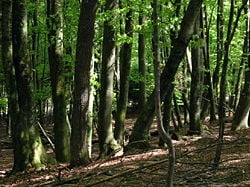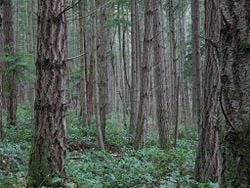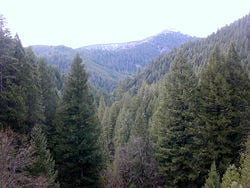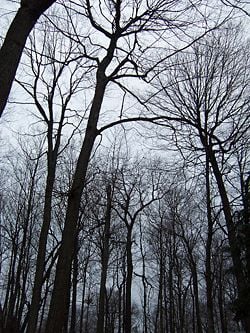Forest
- This article is about forests as communities of trees. For other uses of the word, see Forest (disambiguation).


A forest is an area with a high density of trees (or, historically, a wooded area set aside for hunting). There are many definitions of a forest, based on various criteria [1]. These plant communities cover large areas of the globe and function as animal habitats, hydrologic flow modulators, and soil conservers, constituting one of the most important aspects of the Earth's biosphere. Although often thought of as as carbon dioxide sinks, mature forests are approximately carbon neutral with only disturbed and young forests acting as carbon sinks [2] [3]. Nonetheless mature forests do play an important role in the global carbon cycle as stable carbon pools, and clearance of forests leads to an increase of atmospheric carbon dioxide levels.
Forests can be found in all regions capable of sustaining tree growth, at altitudes up to the tree-line, except where natural fire frequency is too high, or where the environment has been impaired by natural processes or by human activities. As a general rule, forests dominated by angiosperms (broadleaf forests) are more species-rich than those dominated by gymnosperms (conifer, montane, or needleleaf forests), although exceptions exist (for example, species-poor aspen and birch stands in northern latitudes). Forests sometimes contain many tree species within a small area (as in tropical rain and temperate deciduous forests), or relatively few species over large areas (e.g., taiga and arid montane coniferous forests). Forests are often home to many animal and plant species, and biomass per unit area is high compared to other vegetation communities. Much of this biomass occurs below-ground in the root systems and as partially decomposed plant detritus. The woody component of a forest contains lignin, which is relatively slow to decompose compared with other organic materials such as cellulose or carbohydrate.
Forests are differentiated from woodlands by the extent of canopy coverage: in a forest the branches and foliage of separate trees often meet or interlock, although there can be gaps of varying sizes within an area referred to as forest. A woodland has a more continuously open canopy, with trees spaced further apart, which allows more sunlight to penetrate to the ground between them (see also savanna).
Among the major forested biomes are:
- rain forest (tropical and temperate)
- taiga
- temperate hardwood forest
- tropical dry forest
Classification
Forests can be classified in different ways and to different degrees of specificity. One such way is in terms of the "biome" in which they exist combined with leaf longevity of the dominant species (whether they are evergreen or deciduous). Another distinction is whether the forests composed predominantly of broadleaf trees, coniferous (needle-leaved) trees, or mixed.
- Boreal forests occupy the subarctic zone and are generally evergreen and coniferous.
- Temperate zones support both broadleaf deciduous forests (e.g., temperate deciduous forest) and evergreen coniferous forests (e.g., Temperate coniferous forests and Temperate rainforests). Warm temperate zones support broadleaf evergreen forests, including laurel forests.
- Tropical and subtropical forests include tropical and subtropical moist forests, tropical and subtropical dry forests, and tropical and subtropical coniferous forests.
- Physiognomy classifies forests based on their overall physical structure or developmental stage (e.g. old growth vs. second growth).
- Forests can also be classified more specifically based on the climate and the dominant tree species present, resulting in numerous different forest types (e.g., ponderosa pine/Douglas-fir forest).
Forest management
The scientific study of forests is referred to as forest ecology, while the management of forests is often referred to as forestry, often with the goal of sustainable resource extraction. Forest ecologists concentrate on forest patterns and processes, usually with the aim of elucidating cause and effect relationships. Foresters often focus on wood extraction and silviculture, including tree regeneration and growth processes.
Forests can be altered when logging, forest fires, acid rain, herbivores, or diseases, among other things, cause damage to trees. In the United States, most forests have historically been affected by humans to some degree, though in recent years improved forestry practices has helped regulate or moderate large scale or severe impacts. However the United States Forest Service estimates that every year about 1.5 million acres (6,000 km²) of the nation’s 750 million acres (3,000,000 km²) of forestland is lost to urban sprawl and development. It is expected that the South alone will lose 20 to 25 million acres (80,000 to 100,000 km²) to development.
Globally two types of forests can be identified: Natural and Anthropogenic.
Natural forests contain only the original patterns of biodiversity. the native species occurring in established seral patterns. These formations and processes have not been impacted by humans with a frequency or intensity to change established seral patterns
Anthropogenic forests have been impacted by humans with a frequency or intensity to change established seral patterns. Often, they contain elements of exotic species.
Notes
- ↑ Lund, H. Gyde (coord.) 2006. 'Definitions of Forest, Deforestation, Afforestation, and Reforestation'. Gainesville, VA: Forest Information Services. Available from : http://home.comcast.net/~gyde/DEFpaper.htm
- ↑ Broeker, W.S., 2006 "Breathing easy, Et tu, O2" Columbia University http://www.columbia.edu/cu/21stC/issue-2.1/broecker.htm
- ↑ Pregitzer, K. and Uskirchen, S. 2004 "Carbon cycling and storage in world forests: biome patterns related to forest age.", Global Change Biology 10, 1–26
ReferencesISBN links support NWE through referral fees
- 2006-01-13, Sciencedaily: Deep-rooted Plants Have Much Greater Impact On Climate Than Experts Thought Citat: "...The tap roots transfer rainwater from the surface to reservoirs deep underground and redistribute water...increases photosynthesis and the evaporation of water...by 40% in the dry season...During the wet season, these plants can store as much as 10% of the annual precipitation as deep as 13 meters (43 feet) underground, to be tapped during the dry months...tree roots acting like pipes to allow water to shift around much faster than it could otherwise percolate through the soil..."
See also
- General
- Biosphere
- Cloud forest
- Ecological succession
- Forest Schools
- Jungle (terrain)
- Old growth forest
- Plant
- Plantation
- Primeval forest, a term often used interchangeably with old growth forest
- Rainforest
- Royal forest
- Taiga, a biome characterized by coniferous forests
- Temperate broadleaf and mixed forests
- Temperate coniferous forests
- Tree
- Tropical and subtropical coniferous forests
- Tropical and subtropical moist broadleaf forests
- vegetation
- Activities related to forest
- Controlled burn
- Deforestation
- Ecological Thinning
- Fir waves
- Logging and illegal logging
- Reforestation
- Shifting cultivation
- Sustainable forest management
- Hardwood Timber Production
- Forests by country
- Forests of Sweden
- Forests in the United Kingdom
- U.S. National Forest
- Lists
- List of forests
- List of trees in Canadian forests
- List of U.S. state forests
External links
- Global Forest Resources Assessment 2005 by the FAO
- Forests A popularized version of the FAO report, by GreenFacts.
Credits
New World Encyclopedia writers and editors rewrote and completed the Wikipedia article in accordance with New World Encyclopedia standards. This article abides by terms of the Creative Commons CC-by-sa 3.0 License (CC-by-sa), which may be used and disseminated with proper attribution. Credit is due under the terms of this license that can reference both the New World Encyclopedia contributors and the selfless volunteer contributors of the Wikimedia Foundation. To cite this article click here for a list of acceptable citing formats.The history of earlier contributions by wikipedians is accessible to researchers here:
The history of this article since it was imported to New World Encyclopedia:
Note: Some restrictions may apply to use of individual images which are separately licensed.


